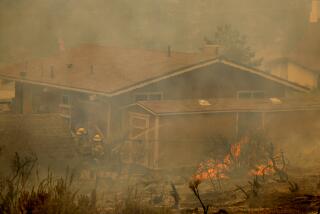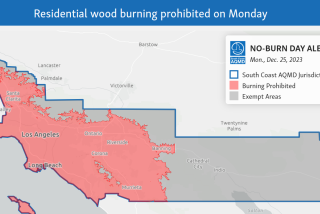At Issue : Should Wood Roofs Be Banned? : NO : Cedar Shingles Can Be as Safe as Alternatives
Shipbuilders in the mid-19th century scoffed at the notion that vessels could be made of steel. Everybody knew steel was heavier than water; steel boats would sink like stones.
Today we are seeing this same logic being applied by some public officials to the subject of wood roofs.
Because everybody âknowsâ wood burns, these officials reject overwhelming evidence that pressure-impregnated cedar shakes are as safe for homes in Los Angeles as any other fire-retardant roofing material.
Councilman Hal Bernson and others cite last yearâs fires in Granada Hills as âproofâ that wood roofs are unsafe. Actually the roofs involved in those--and other major Southern California fires--were not composed of pressure-impregnated fire-retardant shakes and are not permitted under the current building codes.
Nevertheless, the City Council is now considering a ban on all wood roofs in hillside areas, despite the fact that Los Angeles already has one of the most restrictive ordinances in the nation, one that bans standard wood roofing materials everywhere in the city.
As a former state fire marshal and current fire safety consultant to the shake and shingle industry, I oppose this proposed ban and I support existing codes that allow pressure-impregnated fire-retardant cedar shakes and shingles.
These materials, after undergoing a series of rigorous tests developed by Underwriterâs Laboratories, have been certified to meet all current requirements for fire-retardant roofs. Since passage of this ordinance in 1982, not one fire involving a fire-retardant wood roof has been reported.
In fact, in the 25 years that such materials have been available, I am aware of no pressure-impregnated fire-retardant wood roof anywhere in the United States that has either caught fire from external causes such as flying embers or thrown off burning embers to ignite other roofs.
But how can this be? Everybody âknowsâ wood burns. The answer is that modern science has found a way to block the process that permits wood to burn.
Wood is made up of microscopic cellulose straws held together by lignin, a polymer that acts as a glue and binder. When wood grows, small spaces called lumens are formed, creating a kind of honeycomb in the woodâs cellular structure.
To make wood shakes fire retardant, they are put into a vacuum chamber that pulls all air from the lumens. Then theyâre immersed in a fire-retardant substance and put under pressure, forcing the fire-retardant into the lumens at the very core of the wood. The shakes are then heated in a kiln and cured for several days, locking in the retardant. Once there, there is virtually no way to remove the fire-retardant substance.
The U.S. Forest Service has been testing pressure-impregnated shakes and shingles at its Wisconsin laboratories since 1976, exposing them to flames and burning embers in simulated wind conditions.
In addition, they have exposed the shakes to more than 10 years of weathering in the harsh Wisconsin climate. Yet the shakes retain their fire-retardancy and all evidence indicates the retardancy will last for the life of the wood.
Cedar shakes have long been the roofing materials of choice for thousands of hillside homeowners who appreciate their blend of durability, insulation qualities and rustic attractiveness. Recognizing the publicâs concern over fire safety, the industry has spent millions of dollars to develop a product that would meet more stringent fire codes in areas like Los Angeles.
The proposed City Council ban is heedless of this effort and oblivious to hard scientific evidence. The council is right to be concerned about fire safety in the hillsides, but supporters of the ban on fire-retardant wood roofs have picked the wrong target.
More to Read
Sign up for Essential California
The most important California stories and recommendations in your inbox every morning.
You may occasionally receive promotional content from the Los Angeles Times.










